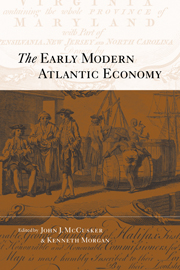Introduction
Published online by Cambridge University Press: 16 October 2009
Summary
As European countries began to expand overseas in the early modern period, transatlantic enterprise became an important conduit for business connections, international migration, the transfer of capital and the establishment of settler societies around the Atlantic littoral. Merchants in European ports established contacts with their counterparts, as well as factors and agents, in port cities in North America, the West Indies and coastal west Africa. They developed complex credit networks and business techniques suited to particular lines of trade. Ships plied the Atlantic sailing routes with cargoes of provisions and manufactured goods destined for markets in Africa and the New World and tropical produce picked up in the Americas for sale in Europe. Some vessels also took on board human cargoes such as European emigrants and African slaves.
This transatlantic commercial activity began as a relatively small-scale affair in the sixteenth century, gathered momentum in the seventeenth century and reached its apogee over the following hundred years. It was in the eighteenth century, at the end of the early modern period, that the integrated transatlantic economy attained its fullest articulation with communication channels that bridged the Atlantic successfully, thanks to growth in the circulation of business news, the organization of fleets, convoys and packets, and the cutting of transit time on various shipping routes.
- Type
- Chapter
- Information
- The Early Modern Atlantic Economy , pp. 1 - 12Publisher: Cambridge University PressPrint publication year: 2001



